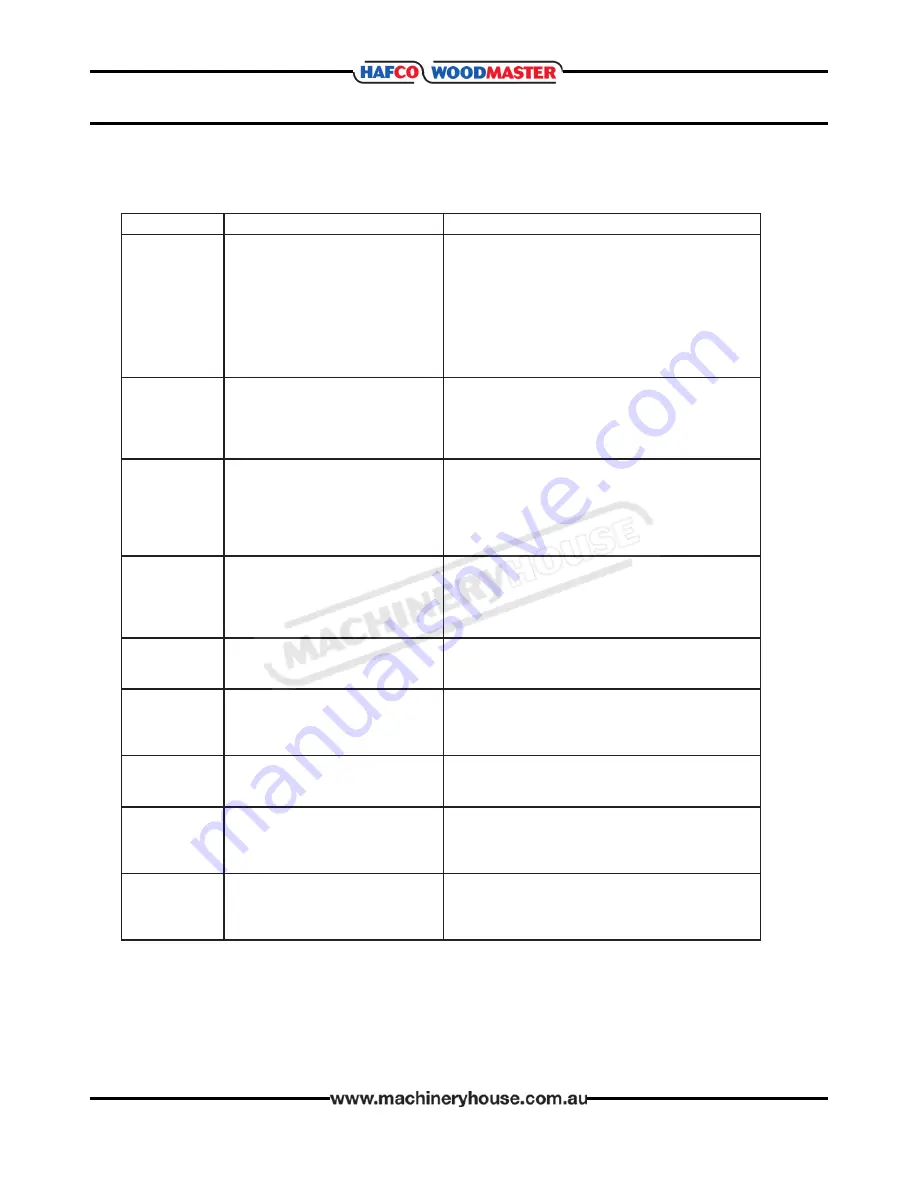
16
OPERATION MANUAL
Sympton
Possible Cause
Possible Solution
Machine does
not start or a
breaker trips.
1. Plug/receptacle is at fault or wired
incor-rectly.
2. Power supply is at fault/switched
OFF.
3. Motor on button or on/oFF switch
is at fault.
4. Wiring is at fault.
5. Motor is at fault.
1. Test for good contacts; correct the wiring.
2. Ensure hot lines have correct voltage on all legs and
main power supply is switched ON.
3. Replace faulty on button or on/oFF switch.
4. Check for broken wires test and repair/replace as
necessary.
5. Test the motor and repair or replace.
Machine stalls or
is under
powered.
1. Plug/receptacle is at fault.
2. Motor bearings are at fault.
3. Motor has overheated.
4. Motor is at fault.
1. Test for good contacts; correct the wiring.
2. Test by rotating shaft; rotational grinding/loose shaft
requires bearing replacement.
3. Clean off motor, let cool, and reduce workload.
4. Test/repair/replace.
Machine has a
vibration or
noisy operation.
1. Motor or component is loose.
2. Motor fan is rubbing on fan cover.
3. Workpiece or chuck is at fault.
4. Motor bearings are at fault.
1. Inspect/replace damaged bolts/nuts, and re-tighten
2. Replace dented fan cover; replace loose/damaged fan.
3. Center workpiece in chuck or face plate; reduce rpm;
replace defective chuck.
4. Test by rotating shaft; rotational grinding/loose shaft
requires bearing replacement.
Vibration noise
while machine
is running or
when speed is
changed
1. Belt cover loose.
2. Belt cover bent or dented and is
making contact with the motor pulley
or belt.
1. Tighten the belt cover lock handle; if necessary
2. Remove belt cover and inspect the inside for dents
bends, or indications of rubbing. Tap out the dent with a
rubber mallet, bend back into proper shape, or shim belt
cover away from the motor pulley.
Motor is running
but spindle is
not turning.
1. Belt is loose, broken, or has come off
the pulley.
2. Belt broken
1. Inspect belt and tighten, reinstall, or replace if
damaged.
2. Replace the belt
Chisels grab
or dig into the
workpiece.
1. Tool rest set too low.
2. Tool rest set too far from workpiece.
3. Wrong chisel/tool being used.
4. Chisel/tool dull.
1. Set tool rest higher.
2. Move the tool rest closer to the workpiece.
3. Use the correct tool; educate yourself by reading trade
books or seek help from an experienced lathe operator.
Bad surface
finish.
1. Wrong spindle speed.
2. Dull chisel or wrong chisel being
used for the operation.
1. Use trial-and-error to find a better spindle speed.
2. Sharpen chisel or try a different chisel.
Tailstock moves
1. Tailstock mounting bolt loose.
2. Too much clamping pressure ap-
plied by tailstock.
3. Bed surface is oily or greasy.
1. Tighten.
2. Apply less clamping pressure with tailstock.
3. Clean bed surface to remove oil/grease.
Can’t remove
tapered tool
from tailstock
barrel.
1. Tailstock barrel had not retracted all
the way back into the tailstock.
2. Debris was not removed from taper
before inserting into barrel.
1. Turn the barrel handwheel until it forces taper out of
barrel.
2. Always make sure that taper surfaces are clean.
Troubleshooting
Page 17
Instructions Manual for WL-14V (W385)
11/08/2017






















